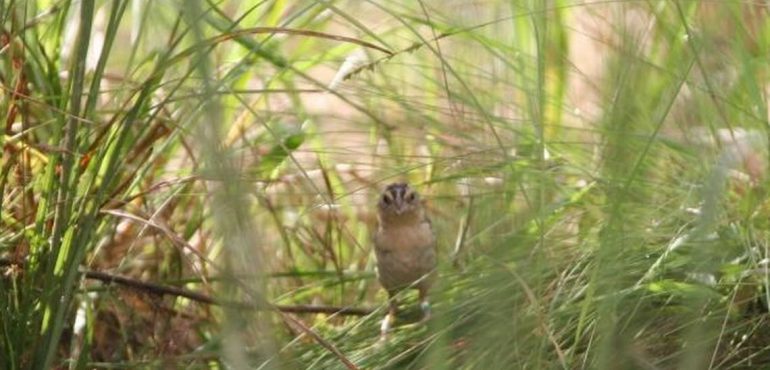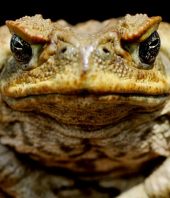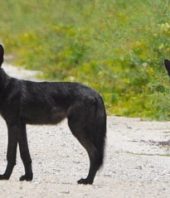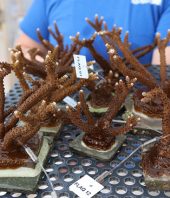North America’s most endangered bird, the grasshopper sparrow that inhabits Central Florida’s shrinking prairie, is facing a new threat: a feud among wildlife managers and scientists.
In a letter to researchers last month, the U.S. Fish and Wildlife Service said it planned to shut down a Palm Beach County breeding program, the larger of only two in the nation, amid ongoing concerns over a newly identified parasite making the birds sick. Federal managers want to free some birds and move others to the second facility in North Florida. Researchers fear those actions could spread the parasite and endanger the last wild population.
The Fish and Wildlife Service also wants to end its partnership with the Rare Species Conservatory Foundation, saying disagreements with the director and a University of Georgia vet are “paralyzing” efforts and could hasten the extinction of the golf ball-sized bird.
But the researchers say the agency’s abrupt decision could be far more hazardous, ignoring warnings to proceed cautiously and take more time to evaluate the parasite identified for the first time just last year.
“This is a classic example to us of shoot, ready, aim, decision-making,” said Paul Reillo, president of the 30-acre conservatory and co-director of Florida International University’s Tropical Conservation Institute. “There’s just so many questions that it begs additional scrutiny.”
In brief statements, federal and state wildlife officials said they were committed to saving the bird.
“The rationale behind our thinking, we think, is obviously the right way to go,” said U.S. Fish and Wildlife Service spokesman Ken Warren.
With less than 80 left in the wild, grasshopper sparrows are considered North America’s rarest bird, part of a family of Florida ground sparrows that have gradually vanished from the landscape. The state originally had eight different sparrows, living among tall grasses in dry prairies and swampy marshes from Central Florida to the Southern Everglades.
But by 1987, two had gone extinct, killed off by habitat loss and other factors. That included the dusky seaside sparrow after a failed attempt to crossbreed five remaining males. Two more sparrows, the grasshopper and Cape Sable sparrow, are now dangerously close to disappearing.
As part of a rescue effort for the grasshopper sparrow, federal wildlife managers enlisted Reillo’s foundation in 2014 to begin a captive breeding effort. Reillo succeeded after two years, becoming the first ever to rear the fragile chicks. White Oak, a 700-acre North Florida sanctuary that also breeds rhinos and cheetahs, soon followed.
But last year, before any birds could be released, young Loxahatchee sparrows began to die mysteriously. Using DNA, Branson Ritchie, a University of Georgia vet and infectious disease expert, identified a novel parasite afflicting the birds. Because they live so close to the soil, the birds are vulnerable to parasites in soil as they forage for bugs.
But the parasite at the Loxahatchee facility had not previously been identified and so far has not been documented in the wild, Ritchie said. While it’s likely the parasite came from wild birds brought to the facility, it’s not clear if it affects captive birds the same as wild birds.
“Birds that came from the wild as youngsters died, but we can’t find it in a wild living creature,” Reillo said. “So is it killing them the same as it’s killing the captive birds? We don’t know. It all comes back to the same three words: We don’t know.”
Before releasing captive birds into the wild population, which would almost surely spread the parasite, Reillo and Ritchie want to understand more precisely how it spreads, what toll it takes on the birds and whether it’s any more dangerous than other parasites. They also want to be sure the parasite is not the X factor driving the sparrows toward extinction or worse, be a new pathogen introduced to wild birds.
“The good news is we’ve developed, through support from the Service’s interest, the methodologies to now find out how these pathogens may be impacting the population,” Ritchie said. “It makes sense to us to now understand that before a mistake is made.”
In emails and meeting minutes, federal and state officials acknowledged releasing the captive birds could threaten the wild population, and agreed there could be a risk of spreading the parasite, even to other species. But after convening other scientists in a disease risk analysis workshop in November, wildlife managers disagreed with Ritchie and Reillo’s conclusion that the parasite represented a new risk. They also disagreed with warnings that birds at the North Florida breeding facility needed to be tested to determine if the same parasite was also killing them.
Not adding captive birds to a shrinking population of wild birds, wildlife managers concluded, posed a bigger risk.
“The consequence of taking no action is unacceptably high,” Florida Fish and Wildlife Conservation Commission avian coordinator Craig Faulhaber emailed Ritchie on Feb. 12. “Staff from both trust agencies understand the risks and uncertainties associated with release of captive-reared Florida grasshopper sparrows, and we accept full responsibility for the outcome of the effort.”
But Reillo worries decisions are being driven less by science and more by funding for the cash-strapped effort. So far, the Service has spent at least $1 million on various conservation efforts and last year, when funding was left out of the budget, helped wage a fundraising effort.
“Are we sacrificing these animals for expediency?” Reillo asked. “Would we rather not know what happened to these animals and how they died? That is not a tenable position for a scientist to be in.”
Reillo said a hurried approach could put them in even more peril. He had suggested housing the birds in soft-sided cages on the prairie and waiting at least three weeks before releasing them to give them time to acclimate to a location 100 miles from the breeding facility. The government scientists believe two days is enough.
“We’ve never done this before and therefore our position is go slowly, go carefully, do a full assessment and make sure your optics are transparent because if this is a bona fide program, we should be able to share it with anyone,” he said.
He’s also puzzled by the Service’s refusal to consider his suggestions, given its support for fundraising efforts that helped him get commitments from sponsors for $60,000 to cover a pilot release program.
“We were offering remedies. These weren’t gauntlets. These were remedies to the situation. And none of those remedies were acceptable,” he said. “Not only were they not acceptable, they said we’re going to end this.”
In a letter emailed to Riello Wednesday, after reporters began calling the Service, project leader Roxanna Hinzmann repeated the agency’s concerns and criticized researchers for not giving their evaluation credit.
“The Service appreciates that Dr. Reillo and Dr. Ritchie have differing views regarding the data and information ... and that you do not agree with the agencies’ decision to pursue releases in 2019 because you believe the potential risk from disease is too great. However, you have misrepresented the agencies’ process and due diligence by asserting that we have ‘elected to dismiss substantiated recommendations.’ “
Warren, the Service’s spokesman, said the disease analysis workshop that Reillo and Ritchie criticized is now undergoing a peer review that invites another round of scrutiny and debate over how to proceed. The findings will determine what the Service does next, he said.
But how do you peer review a workshop?
“That’s a great question,” Reillo said.
While scientists sometimes gather to compile research that can be peer-reviewed, he said the workshop held in November reached no conclusions and made no recommendations.
“This is the kind of case where we have to stand behind the science,” he said. “I’m certainly more comfortable being found wrong because we are being overly cautious, than to find out we were right” about captive birds infecting wild sparrows.
Source: Miami Herald, Full Article






